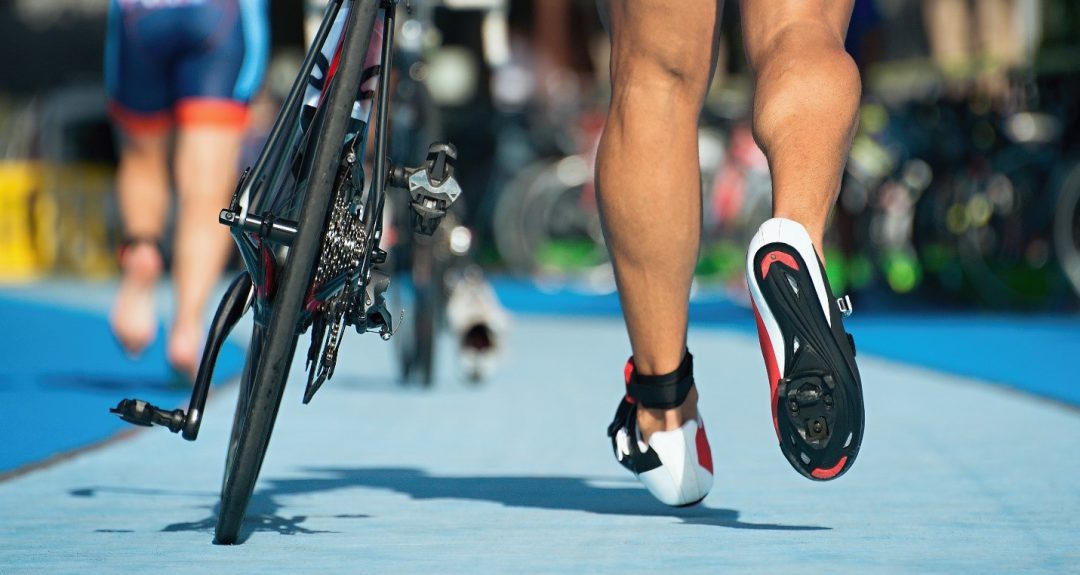Injuries in triathlons can be broadly categorized into acute and repetitive categories. Now there’s not much we can do if someone kicks you in the water or if you crash your bike, so we’ll stick to the repetitive injuries and hone in on knees, backs and shoulders, because this is where the injuries are most prevalent.
As well as this there appears to be the most injuries in running, then cycling and then swimming. Strength and endurance are the main things we want. Strength to power the muscles, to create movement and endurance to do it over and over and over. Good strength is protective for our joints, improves running times and can help relieve pain.
So, what exercises can we use to prevent injuries? Here’s some to consider:
Knees – in running
1. The aim of this exercise is to target control of knee position and to strengthen the calves and quadriceps to reduce impact forces.
Back – on the bike
2. This variation of the plank imitates the bike position and to mimic the muscles being used while you are riding.
Scorpion exercise – lower back
3. The ‘scorpion’ exercise is great for mobilising the lower back to relieve the feeling of stiffness that can occur after being stuck on the bike over a long period.
Shoulders – when swimming
4. Targeting the rotator cuff muscles of the shoulder helps support a good stroke for the front crawl using this resisted band exercise.
These exercises use very little equipment and could be used as an effective warm up prior to training or your event.
Extra Training Tips for injury prevention
The demands of the triathlon season are great as events pile up over an intense period after a long preseason of training:
1. It is advisable to have every third or fourth week as a “down” week to reduce training demands, allow for rest/recovery and adaptation to the training. This means reducing down to between 50-80% of the week’s prior volume and this is much like the idea of tapering in that we expect your energy and performance to improve after having a reduced work load.
2. Following the 10-20% rule for increase in weekly training is a good way to avoids over stressing your body. It’s not a perfect ‘rule’ but has some validity in avoiding training related injury.
3. If we look at the training patterns of the best, we see a spread of training intensity at 80% slow and easy (think conversational running pace) and 20% hard and fast (hard to speak a sentence). Why? Because overtraining at high intensity leads to injuries and lower intensity but long/slow training builds that sorely needed endurance for competition.
Sleep for recovery
Ahh sleep, so many reasons why this is important! Including, but not limited to; immune health, mental health, reduced stress, adaptation of cells in muscles, bone, tendons and ligaments. Get those screens off an hour before bed, showers pre-bed helps to get to sleep more easily and being consistent with a time is also of great value. We all know that bad sleep causes us issues in our daily life and this can feed into injuries, pain states and quite simply just cause fatigue and poor performance.
Nutrition
I’d advise anyone feeling like they are having a hard time getting this right to speak with a Nutritionist. As well as this, the Myfitnesspal app is a great way to keep track of what you’re eating and its nutritional value, even if you only use it for a couple of weeks to get a sense of energy in and out in calories.
APPI clinics can offer rehabilitation, running assessments, running programs, general advice and help with all matters of sport and exercise.
Written by Tom West
Sports Physiotherapist- Hampstead clinic
References
Kienstra, C., Asken, T. ,Garcia, Jennifer D., Lara, V., Best, T. (2017)Triathlon Injuries – Transitioning from Prevalence to Prediction and Prevention. Current Sports Medicine Reports 16 (6).
Shaw, T., Howat. P., Trainor M. & Maycock, B. (2004). Training patterns and sports injuries in triathletes. Journal of Science and Medicine in Sport, 7 (4), Pp 446-450.
Vleck, V. & Bessone Alves, F. (2011) Triathlon injury review – IOC World Conference on Prevention of Injury & Illness in Sport. BJSM, 45 (5).

